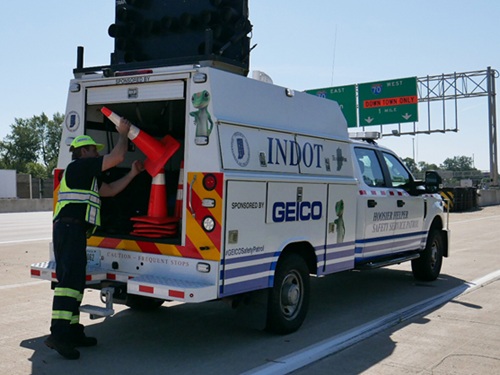The U.S. Department of Transportation recently issued $5 million in research funding to the Rutgers University Center for Advanced Infrastructure and Transportation or CAIT to help develop the “next generation” of infrastructure construction materials.
[Above photo by the USDOT]
“This research initiative will develop and advance innovative materials and technologies that support the nation’s goals to decarbonize the transportation sector, strengthen resilience of the nation’s transportation infrastructure, and address adverse environmental impacts created by the transportation system,” said Dr. Robert C. Hampshire, USDOT’s principal deputy assistant secretary for research and technology and chief science officer, in a statement.
Several other academic institutions, along with steel and cement companies, will work with CAIT in this research initiative, including: the New Jersey Institute of Technology, Oregon State University, University of Florida, Lafarge Holcim U.S., Seattle TMS International, Nucor Steel Berkeley, Edward C. Levy & Company, and the Slag Cement Association.

This funding award is part of a larger effort USDOT Secretary Pete Buttigieg touched on during a session in January at the Transportation Research Board’s 2024 Annual Meeting in Washington, D.C., regarding the development of new infrastructure materials to help “reinvent” roadways, airport runways, and railroad networks.
“Our aim is to make infrastructure materials like [road] pavement more effective, resilient, durable, and longer lasting than ever before,” Buttigieg explained. “It’s about making the right kind of investments not just to rebuild our nation’s infrastructure but to redefine how it is built.”
He added that while only 60 years separated the first airborne flight at Kitty Hawk, N.C., and America putting a man on the moon, the transportation industry still relies on infrastructure materials in use during the Roman Empire.
“Our role, then, at USDOT, is to make sure we have a good understanding of the role of materials we use in transportation and how they are encoded into the decisions we make,” Buttigieg said.
“There is a very low level of attention paid to materials research, but an even marginal change in quality could be massive if multiplied out among all the projects we work on. There are things literally going on under our noses that could provide so much opportunity for us in terms of providing materials with intelligence, more durability, and sustainability,” he stressed. “I urge you to continue this work. Really, in the grand scale of things, this is not just money-saving research but lifesaving as well. Do not let anyone tell you materials are not glamorous.”
Several state departments of transportation are already at work testing a variety of different materials to meet infrastructure construction needs.
For example, the Montana Department of Transportation recently detailed in a video its work with Montana State University to develop a lower cost Ultra-High Performance Concrete or UHPC formula. After years of developing and thoroughly testing a new UHPC formula in the laboratory, the team put it to work when replacing two badly deteriorated concrete bridges in southwest Montana.
Meanwhile, in July, the Illinois Department of Transportation signed a six-year $48 million agreement with the University of Illinois Urbana-Champaign’s Illinois Center for Transportation to continue a longtime joint research program.
That agreement aims to help Illinois DOT solve key transportation challenges, such as creating safer and more sustainable infrastructure, reducing congestion, achieving more equitable transit systems, preparing for autonomous vehicles, and more.
At the top of the list of priorities is developing and implementing next-generation mobility technologies while ensuring a safe, resilient and net-zero emission transportation system by 2050, Illinois DOT said.
 Nation
Nation
Confusion Reduces ‘Slow Down, Move Over’ Law Impact
November 14, 2025 Nation
Nation

